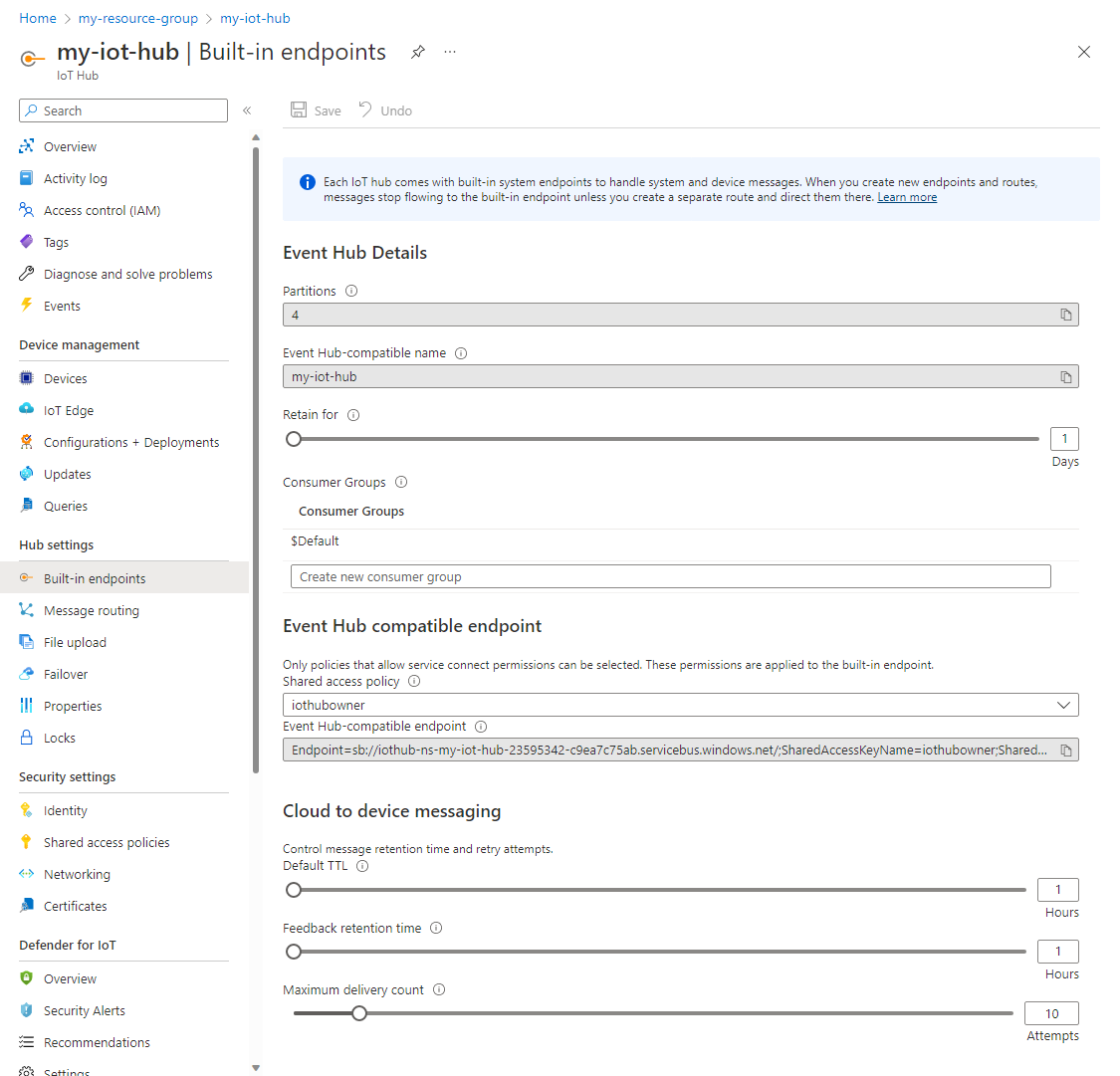Note
Access to this page requires authorization. You can try signing in or changing directories.
Access to this page requires authorization. You can try changing directories.
By default, messages are routed to the built-in service-facing endpoint (messages/events) that is compatible with Event Hubs. IoT Hub exposes the messages/events built-in endpoint for your back-end services to read the device-to-cloud messages received by your hub. This endpoint is Event Hubs-compatible, which enables you to use any of the mechanisms the Event Hubs service supports for reading messages.
If you're using message routing and the fallback route is enabled, a message that doesn't match a query on any route goes to the built-in endpoint. If you disable this fallback route, a message that doesn't match any query is dropped.
This endpoint is currently only exposed using the AMQP protocol on port 5671 and AMQP over WebSockets on port 443. An IoT hub exposes the following properties to enable you to control the built-in Event Hubs-compatible messaging endpoint messages/events.
| Property | Description |
|---|---|
| Partition count | Set this property at creation to define the number of partitions for device-to-cloud event ingestion. |
| Retention time | This property specifies how long in days IoT Hub retains messages. The default is one day, but it can be increased to seven days. |
IoT Hub allows data retention in the built-in endpoint for a maximum of seven days. You can set the retention time during creation of your IoT hub. Data retention time in IoT Hub depends on your IoT hub tier and unit type. In terms of size, the built-in endpoint can retain messages of the maximum message size up to at least 24 hours of quota. For example, one S1 unit IoT hub provides enough storage to retain at least 400,000 messages, at 4 KB per message. If your devices are sending smaller messages, they might be retained for longer (up to seven days) depending on how much storage is consumed. We guarantee to retain the data for the specified retention time as a minimum. After the retention time, messages expire and become inaccessible. You can modify the retention time, either programmatically using the IoT Hub resource provider REST APIs, or with the Azure portal.
IoT Hub also enables you to manage consumer groups on the built-in endpoint. You can have up to 20 consumer groups for each IoT hub.
Connect to the built-in endpoint
Some product integrations and Event Hubs SDKs are aware of IoT Hub and let you use your IoT hub service connection string to connect to the built-in endpoint.
When you use Event Hubs SDKs or product integrations that are unaware of IoT Hub, you need an Event Hubs-compatible endpoint and Event Hubs-compatible name. You can retrieve these values from the portal as follows:
Sign in to the Azure portal and navigate to your IoT hub.
Select Built-in endpoints from the resource menu, under Hub settings.
The Built-in endpoints working pane contains three sections:
- The Event Hub Details section contains the following values: Partitions, Event Hub-compatible name, Retain for, and Consumer Groups.
- The Event Hub compatible endpoint section contains the following values: Shared access policy and Event Hub-compatible endpoint.
- The Cloud to device messaging section contains the following values: Default TTL, Feedback retention time, and Maximum delivery count.
In the working pane, the Event Hub-compatible endpoint field contains a complete Event Hubs connection string that looks like the following example:
Endpoint=sb://abcd1234namespace.servicebus.chinacloudapi.cn/;SharedAccessKeyName=iothubowner;SharedAccessKey=keykeykeykeykeykey=;EntityPath=iothub-ehub-abcd-1234-123456
If the SDK you're using requires other values, then they would be:
| Name | Value |
|---|---|
| Endpoint | sb://abcd1234namespace.servicebus.chinacloudapi.cn/ |
| Hostname | abcd1234namespace.servicebus.chinacloudapi.cn |
| Namespace | abcd1234namespace |
You can then choose any shared access policy from the Shared access policy drop-down, as shown in the previous screenshot. It only shows policies that have the ServiceConnect permissions to connect to the specified event hub.
SDK samples
The SDKs you can use to connect to the built-in Event Hubs-compatible endpoint that IoT Hub exposes include:
Connect to other service and products
The product integrations you can use with the built-in Event Hubs-compatible endpoint that IoT Hub exposes include:
-
For more information, see Azure IoT Hub bindings for Azure Functions.
-
For more information, see Stream data as input into Stream Analytics.
-
For more information, see Add an IoT hub event source to your Azure Time Series Insight environment.
-
For more information, see the Apache Kafka developer guide for Azure Event Hubs.
Next steps
For more information about IoT Hub endpoints, see IoT Hub endpoints.
If you want to route your device-to-cloud messages to custom endpoints, see Use IoT Hub message routing to send device-to-cloud messages to Azure services.
